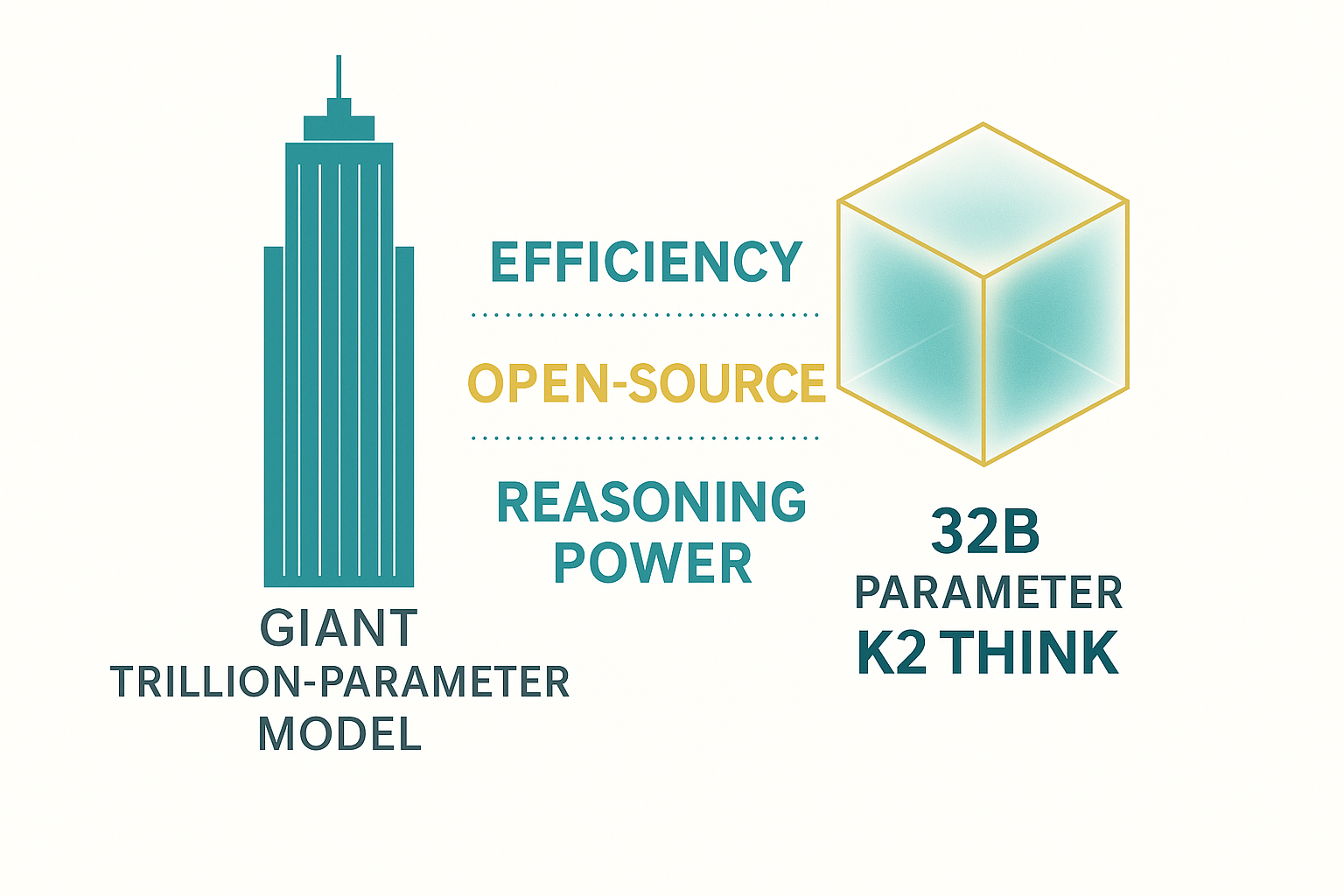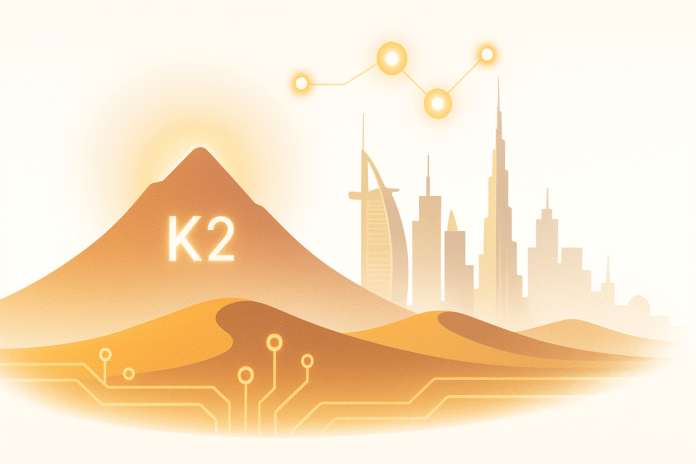Artificial intelligence has long been dominated by the mantra “bigger is better.” The prevailing assumption is simple: the more parameters a model has, the more intelligent and more capable it becomes. But the United Arab Emirates has just made a bold move to challenge that narrative.
Through the combined efforts of the Mohamed bin Zayed University of Artificial Intelligence (MBZUAI) and Abu Dhabi’s tech powerhouse G42, the UAE has launched K2 Think—a compact yet astonishingly powerful reasoning model boasting 32 billion parameters.
Despite being a fraction of the size of the massive large language models (LLMs) built by companies like OpenAI, DeepSeek, or Anthropic, K2 Think is already making waves by outperforming—or at least equalling—these giants on advanced reasoning tasks in mathematics and science.
This isn’t just another AI release. It’s a statement of intent. The UAE is positioning itself as a serious player in the global AI race, with K2 Think as its banner achievement.
A Small Package, Fierce Punch
The most fascinating aspect of K2 Think is how much it achieves with its relatively modest size. Thirty-two billion parameters might sound huge to the average reader, but in today’s AI landscape, it’s considered “compact.” DeepSeek, for instance, has built models surpassing 600 billion parameters—gargantuan creations that require astronomical computational resources to train and operate.
Yet, on key benchmarks, K2 Think matches or even surpasses these giants. How? Through wise engineering choices:
- Chain-of-thought fine-tuning: Training the model to reason step by step, mimicking how a human might carefully solve a math problem rather than blurting out an answer.
- Agentic planning: Giving the model an internal “planner” that helps it organise information and structure responses with purpose.
- Reinforcement learning with verifiable rewards: Optimising the model not just for performance, but for provably correct answers in reasoning-heavy domains.
- Test-time scaling: Allowing the model to “think harder” during inference by expanding the number of reasoning paths it considers before producing a final response.
Together, these methods create a kind of intellectual efficiency. Instead of relying on brute-force scale, K2 Think shows that careful design and transparency can yield a model that punches well above its weight.

Built for Transparency and Accessibility
One of the biggest complaints about frontier AI models from Silicon Valley is their opacity. Companies like OpenAI and Anthropic guard their training data, model weights, and sometimes even basic performance metrics. K2 Think flips that model on its head.
The UAE has released K2 Think with:
- Open-source code
- Training data
- Weights
This means that developers, researchers, and curious tinkerers around the world can not only use the model but also study it, critique it, improve it, and adapt it for regional or industry-specific needs.
Even more impressive is the hardware side. K2 Think runs on Cerebras chips—specialised hardware designed for inference speed. The result? The model can process 2,000 tokens per second, making it extremely fast in real-world applications.
Transparency isn’t just a buzzword here. By making the entire model stack openly accessible, the UAE is planting a flag for an AI future that is collaborative, not monopolised.
Why K2 Think Matters
A philosophical shift is unfolding in AI research. For years, bigger models were equated with better performance. But the diminishing returns of scale are becoming clear. Training models with hundreds of billions—or even trillions—of parameters requires enormous energy consumption, specialised hardware clusters, and eye-watering budgets.
K2 Think challenges this by showing that efficiency and clever design may rival sheer size. This matters for several reasons:
- Accessibility: Smaller, open models can be utilised by a broader range of researchers, startups, and governments worldwide.
- Energy efficiency: Training and running a 32B model consumes a fraction of the resources required for trillion-parameter behemoths.
- Democratisation of AI: With open-source availability, knowledge creation is no longer the exclusive domain of corporate labs in San Francisco, Seattle, or Beijing.
In short, K2 Think is not just a technical achievement—it’s a philosophical challenge to the prevailing dogma of AI scale.
A Strategic Play by the UAE
The UAE’s AI ambitions are not a new development. MBZUAI has steadily built a reputation as one of the world’s first universities dedicated entirely to artificial intelligence. G42, meanwhile, has invested billions in infrastructure, cloud services, and AI products across various industries, from healthcare to energy.
K2 Think is not a one-off experiment. It’s part of a deliberate pattern. Alongside K2 Think, MBZUAI has already released:
- Jais: A model explicitly tuned for Arabic.
- NANDA: A Hindi-focused language model.
- Other regional and domain-specific models are designed to empower local developers.
This growing portfolio signals the UAE’s ambition to be more than just a customer of Western AI products. It wants to be a producer—a global hub for innovation, not just adoption.
And the symbolism of K2 Think’s name shouldn’t be missed. K2 is the second-highest mountain in the world, known for its difficulty and danger. Naming the model after this peak is a bold metaphor: the UAE is climbing into the rarified air of global AI leadership.
A Thought Experiment: A Tapestry of Knowledge Centres
What if every corner of the world developed its own version of K2 Think? Imagine:
- Latin America releases open-source models tuned for Spanish, Portuguese, and indigenous languages.
- Africa builds compact reasoning systems that understand Swahili, Hausa, Yoruba, and Amharic.
- Southeast Asia trains models optimised for Thai, Tagalog, and Bahasa Indonesia.
The result would be a global tapestry of knowledge centres. Instead of a handful of corporations monopolising AI, we’d see a distributed ecosystem of regionally tuned, open, and adaptable models.
Such a future could rebalance the power dynamics of AI. It would enable nations to develop models tailored to their cultural values, linguistic needs, and local contexts—without relying on Western or Chinese tech giants.
Challenges
Of course, the road ahead for K2 Think is not without hurdles. Open-source models can be misused just as easily as they can be innovated upon. Issues of bias, misinformation, and malicious deployment will need careful governance.
Furthermore, while K2 Think’s reasoning abilities are impressive, it will need to prove its robustness in everyday use cases—from enterprise applications to consumer products. Competing with trillion-parameter systems may be exciting in benchmarks, but real-world deployment is the actual test.
Finally, the UAE will need to navigate geopolitical concerns. As open-source AI becomes a national strategy, questions about data governance, international collaboration, and ethical responsibility will grow louder.
The Bigger Picture
K2 Think represents something bigger than itself. It is a signal flare announcing that a few mega-corporations do not predetermine the future of AI. Innovative design, open principles, and regional investment can produce models that rival the giants.
For the UAE, this is both a technological achievement and a geopolitical statement: we are here, we are capable, and we are building for the world.
And for the rest of us, K2 Think is a reminder that intelligence—whether human or artificial—doesn’t always come from size alone. Sometimes it comes from clarity, efficiency, and openness.
Final Thoughts
If the world embraces the spirit of K2 Think—compact, transparent, and collaborative—we may find ourselves in an AI future less dominated by monopolies and more shaped by diverse voices. The question is: will others follow the UAE’s lead, or will the mountain remain too steep to climb?

